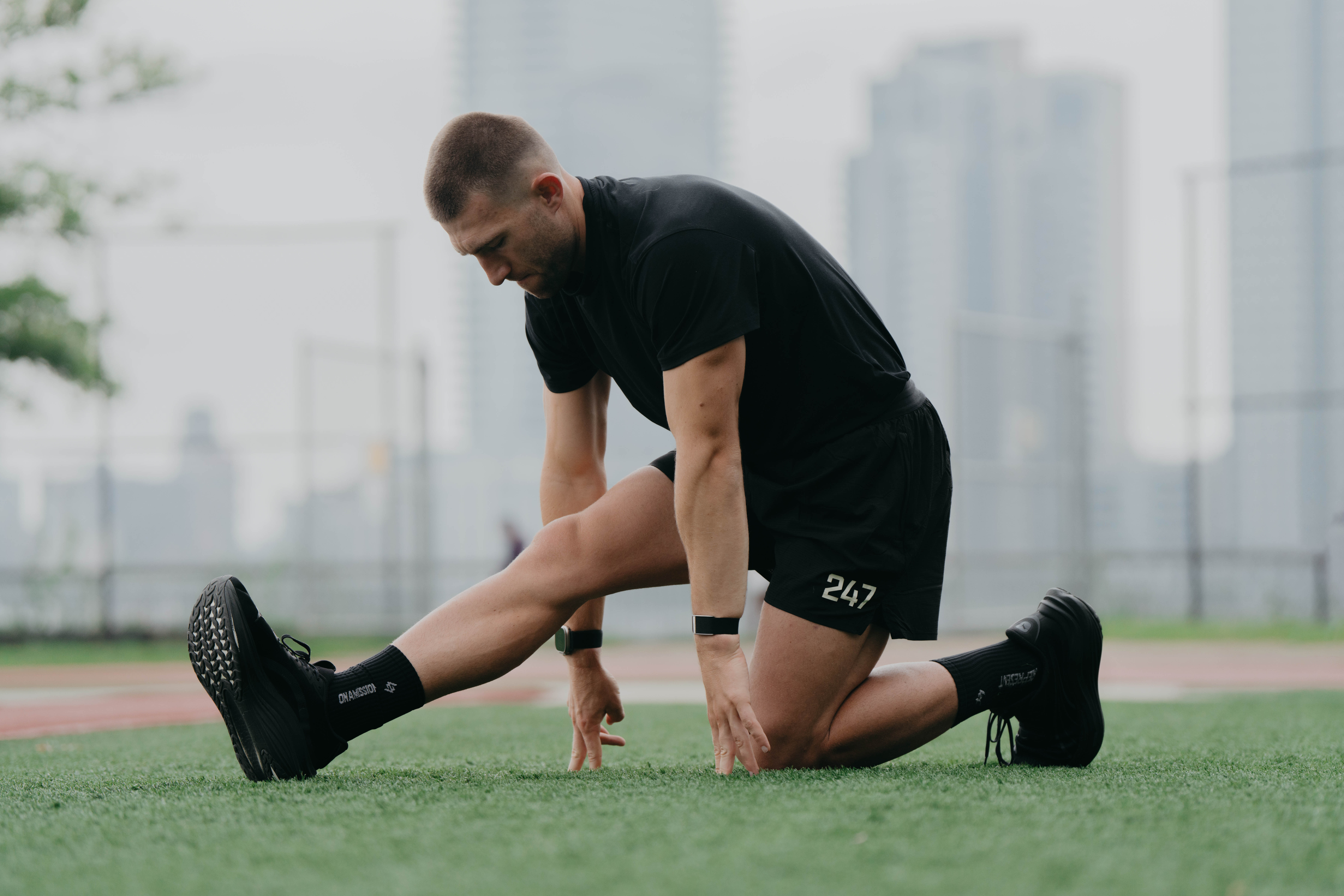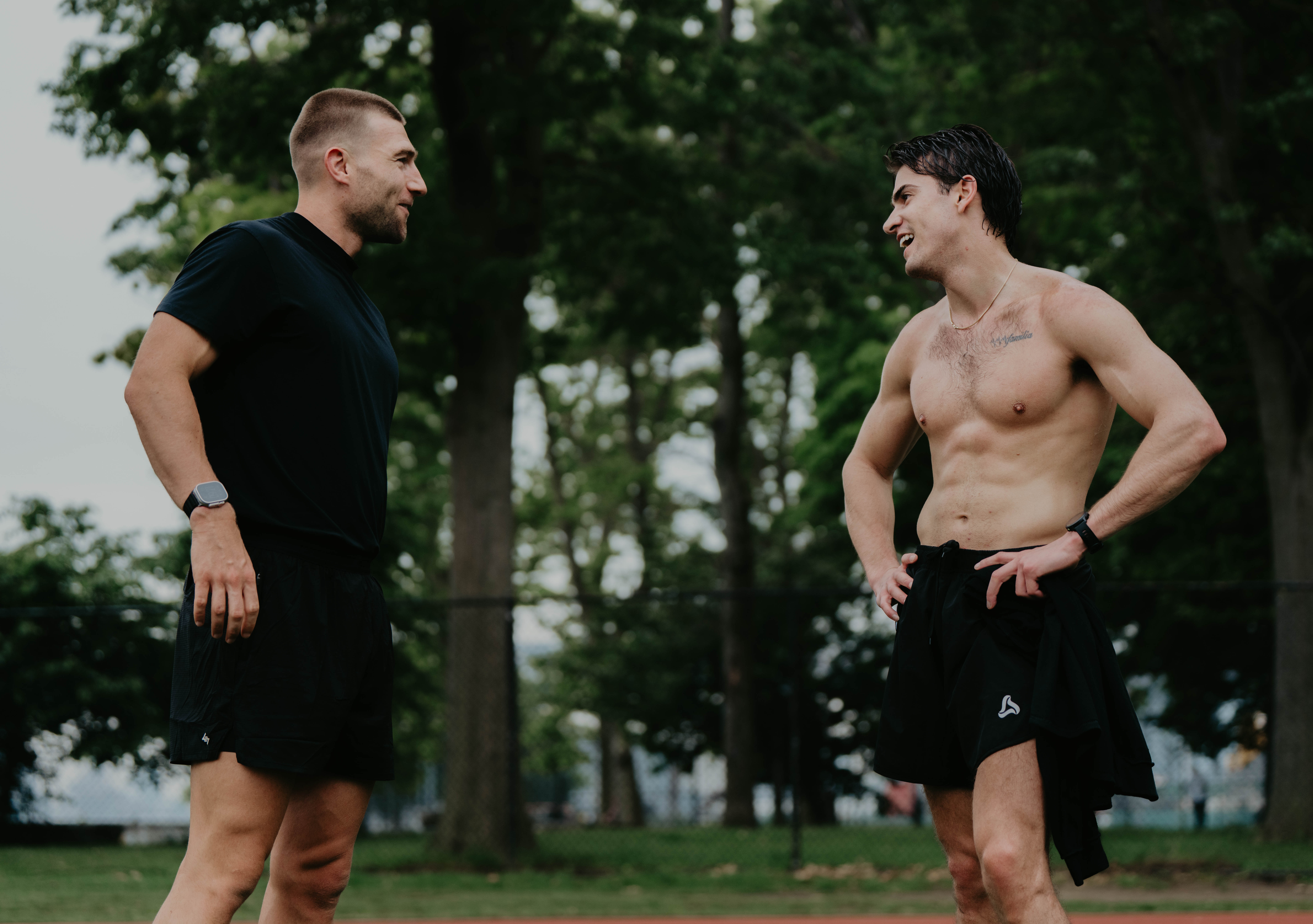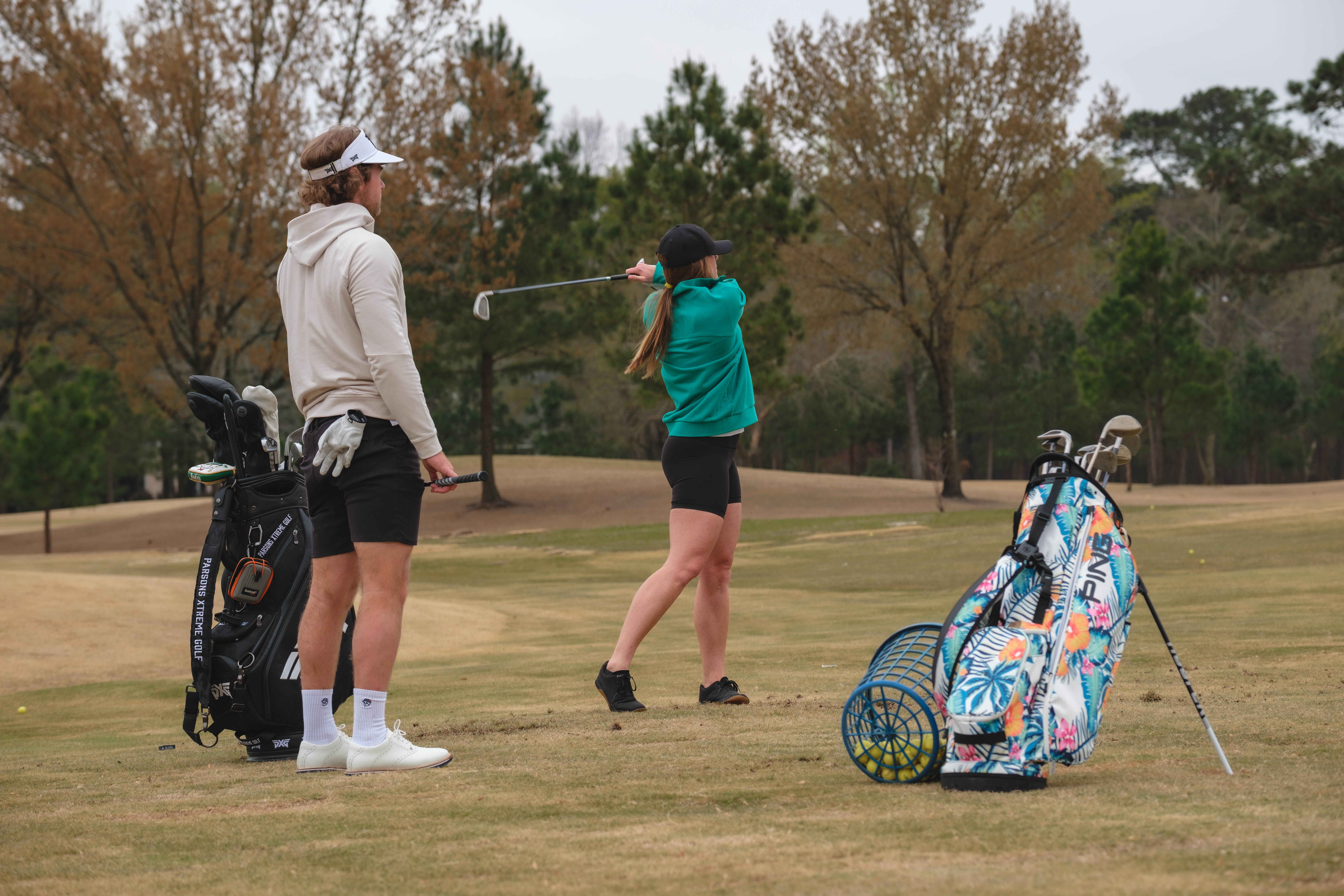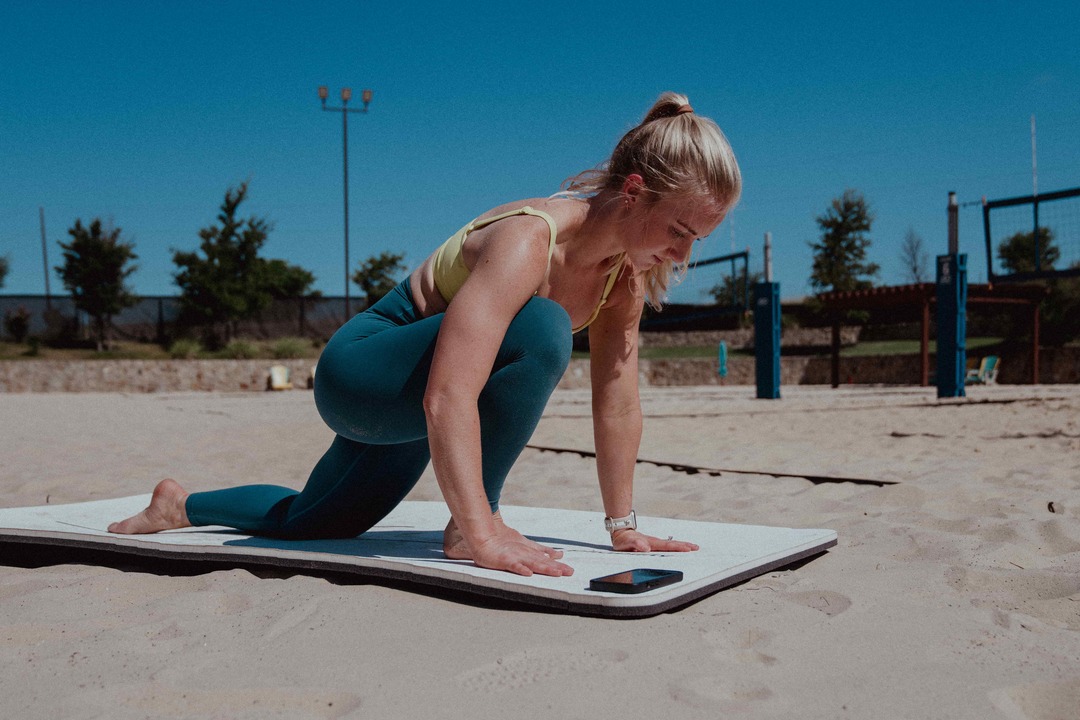Golf is challenging enough without battling tight shoulders, stiff hips, or a sore lower back. The truth is, most golfers walk straight to the first tee without preparing their bodies, and it shows in shorter drives, inconsistent swings, and nagging aches. That’s where pre-golf stretches make all the difference. By targeting mobility, rotation, and core stability, the proper warm-up routine helps you swing freely, stay injury-free, and play with confidence from the very first hole. In this guide, you’ll discover 20+ simple stretches and dynamic movements designed specifically for golfers. If you’ve been searching for the best stretching excercises to improve flexibility, increase swing power, and reduce injuries, these routines will help you loosen up fast and perform your best.
Pliability's mobility app offers short guided pre-round routines that blend dynamic stretches, activation moves, and gentle flexibility work so you warm up the correct muscles and protect your body while boosting distance and consistency.
How Can Stretching Make You a Better Golfer?

On a quest to become a better golfer, you might invest in new clubs, practice at the range, and hire a coach. But often the limiting factor is the body. “the real issue is that your body just won’t let you move a certain way. The new club technology is designed to eliminate your slice or hook, but if you had the flexibility and strength to perform the proper golf movement, you could solve it without spending a fortune,” says Keith Sobkowiak, a doctor of physical therapy and Titleist Performance Institute certified clinician.
If your joints and soft tissues restrict where the club can go, no amount of tech or practice will fully close the gap between where your swing is and where it needs to be.
Mobility Versus Static Stretching: Rethinking Pre-Golf Stretches
“A lot of folks think of static stretching when they see the word ‘stretching,’ and that really does not do justice to what we are talking about, related to accessing more range of motion to improve our golf swing mechanics,” Selena Samuela explains. “I like to use the term ‘mobility’ instead of ‘stretching.’” Mobility blends flexibility with strength, coordination, and control so you can use a new range of motion during a fast, loaded movement like a swing.
How a Greater Range of Motion Improves Swing Mechanics
When your shoulders, thoracic spine, and hips rotate efficiently, the kinematic sequence of the swing flows:
- Hips initiate
- Torso follows
- Then the arms and clubhead
Selena puts it plainly: “If you can do more with your body, you can do more with your swing.” Increased rotation and separation allow a better swing plane and proper wrist and club positions, which create cleaner contact and predictability. That extra usable range often translates into longer drives, straighter iron shots, and fewer misses.
Key Mobility Restrictions That Cost Yardage and Consistency
Three common mechanical culprits show up repeatedly:
- Hip stiffness that blocks rotation and weight shift
- Mid back tightness that limits backswing and follow-through
- Poor core control prevents the upper and lower body from moving independently
Those limits force compensations, early extension, overactive arms, or casting, and cost distance and consistency
How Stretching Lowers Injury Risk on the Course
Many golf injuries target the spine, wrists, elbows, shoulders, and knees. Dan Kelley, MD, points out that a deliberate warm-up and cooldown to “sandwich” each round and practice session primes tissues and reduces risk.
When mobility improves, you stop overloading one joint or muscle group to make up for another, which cuts down acute strains and chronic overuse problems. That reduction in compensatory movement protects your back and shoulders while keeping you on the course more often.
Why More Mobility Can Increase Swing Speed and Power
Power in the golf swing depends on separated motion between the hips and the torso, elastic energy storage, and a clean energy transfer from the ground through the core to the hands. A greater usable range lets you create a larger X factor and load tissues effectively, then release that energy into the ball. Better mobility also removes the feeling of restriction, so you can accelerate confidently through impact rather than pulling up to avoid pain.
Practical On-Course Benefits Golfers Will Notice
- Hitting longer drives and improved clubhead speed as rotation and separation expand.
- More consistent ball striking because the club follows a more repeatable path.
- Less back and shoulder pain thanks to balanced motion and reduced compensation.
- Better posture through the round by maintaining readiness in posture muscles.
- Reduced muscle tension and soreness after play, supporting quicker recovery.
- Heightened focus and calm pre-shot when you're warming up prepares both body and mind.
Performance Details That Matter for a Pre-Round Routine
Think of pre-golf stretches as a performance primer:
- They increase the usable range
- Activate the right muscle chains
- Reduce unnecessary tension
- Prepare yourself to swing hard and repeat it
Use mobility work and dynamic warm-up principles to target the spine, hips, shoulders, and core so your swing mechanics can operate within the plane you want and without protective guarding that kills speed.
Related Reading
- Why Does Stretching Feel Good
- Does Stretching Burn Calories
- Does Stretching Help Sore Muscles
- Most Important Muscles for Golf
- Why Do Athletes Stretch Before a Game
- Does Stretching Build Muscle
- Stretches to Do Before Working Out
- Leg Stretches Before Workout
- Full Body Stretching Routine
- Golf Stretching Routine
- Chest Stretches After Workout
Top 20+ Pre-Golf Stretches to Improve

1. Wrist Figure 8s: Wake the Forearms and Shoulders
Stand feet shoulder-width apart, knees soft. Interlock fingers to clasp hands and lift palms to shoulder height. Flip left hand over right, then right over left, tracing a sideways figure eight in the air with smooth, controlled motion. Keep your shoulders relaxed and breathe steadily.
- Reps/duration: 20 figure 8s continuous.
- Muscles and joints worked: Shoulders, wrists, forearms.
- Golf benefit: Improves wrist and shoulder coordination for a smoother release and better clubface control.
- Quick cue: Move deliberately, not fast; quality of motion beats speed here.
2. Rotational Lat Stretch: Open the Back for Better Turn
Stand in front of a sturdy vertical bar or pole with feet shoulder-width apart. Grasp the pole with your right hand. Step one foot 8 to 12 inches back, hinge at the hips, and sink into a half squat with knees loose. With the right hand secure, bring the left arm across your chest and under the right armpit, then rotate back to center.
- Reps/duration: 10 reps each side.
- Muscles worked: Latissimus dorsi, shoulders, upper back.
- Golf benefit: Loosens the lats and thoracic area to allow fuller shoulder turn and stronger rotation.
- Quick cue: Keep the hips stable while the chest turns.
3. Windmill Turns: Built for Torso Mobility and Core Control
Stand feet shoulder-width apart, knees soft. Place a golf club horizontally behind your neck across both shoulders and hold each end so your arms form a W. Engage the core and rotate your torso left, then right while keeping your hips quiet.
- Reps/duration: 20 twists total, alternating sides.
- Muscles worked: Back, obliques, abs.
- Golf benefit: Trains coordinated torso rotation for a consistent swing plane and better sequencing.
- Quick cue: Lead with the chest, not the hips, on each turn.
4. 4-Way Leg Swings: Dynamic Hip and Hamstring Mobility
Stand within arm's reach of a pole or cart and hold it for support. Keep core engaged and knees soft. Swing your right leg straight out to the right, back to center, then across the body to the left and back. Keep your torso steady and avoid swaying.
- Reps/duration: 10 swings per direction on each leg (10 right, then 10 left).
- Muscles worked: Hip flexors, glutes, hamstrings, lower back.
- Golf benefit: Improves hip range of motion and weight shift for fuller backswing and follow-through.
- Quick cue: Control the movement; let the hips lead the leg, not the opposite.
5. Assisted Shoulder Stretch: Free Up the Rotator Cuff and Front Shoulder
Hold the club in your right hand at 90 degrees. Slowly move the club behind your back and over the right shoulder. Reach across your chest with your left hand, grab the shaft, and gently pull the club farther across your chest until you feel a stretch.
- Reps/duration: Hold end range for 45 seconds, then switch sides.
- Muscles worked: Rotator cuff group, anterior shoulder, and chest.
- Golf benefit: Increases shoulder mobility to reduce compensation during the swing and protect the shoulder.
- Quick cue: Breathe slowly and relax into the stretch while maintaining posture.
6. Elevated Child Pose: Unload the Lower Back and Hips
Place the driver upright three feet in front of you and grip the top of the handle with both hands. Hinge at the hips and walk your hands forward as you lower your chest toward your thighs until your head rests near your biceps.
- Reps/duration: Hold at least 45 seconds.
- Muscles worked: Lower back, glutes, hip extensors.
- Golf benefit: Relieves low back tension and promotes freer hip rotation during the swing.
- Quick cue: Keep the spine long and breathe into the stretch.
7. Seated Assisted Toe Touch: Target Hamstrings and Calf Flexibility
Sit on the ground with feet slightly apart. Place the club across your feet and reach forward to grab the shaft in the middle. Slowly straighten the legs while pulling your upper body gently toward your feet.
- Reps/duration: Hold 45 seconds. Option: perform standing with the club.
- Muscles worked: Hamstrings, calves, lower back.
- Golf benefit: Freer hamstrings allow a better hip hinge and more consistent posture through the swing.
- Quick cue: Lead with the chest; avoid rounding the lower back.
8. Assisted Lower Body Rotation: Mobilize Hips for a Stronger Finish
Hold the club behind your back at hip height. Rotate your torso into the lead leg as if holding your finished swing position while the club offers gentle leverage. Work to turn deeper into the lead side without forcing the lower back.
- Reps/duration: Rotate for 45 seconds each side.
- Muscles worked: Hips, glutes, obliques, lower back.
- Golf benefit: Increases hip internal rotation for a stable finish and better weight transfer.
- Quick cue: Move into range slowly and stop before any pinching.
9. Elongation Stretch: Stretch the Side Body for More Turn
Hold a golf club overhead with both hands. Reach the club toward the sky while standing tall, then lean slightly laterally to feel length along the side of your torso.
- Reps/duration: 2 to 3 reaches per side, hold 15 to 30 seconds each.
- Muscles worked: Latissimus dorsi, obliques, and shoulders.
- Golf benefit: Lengthens the side body to improve shoulder turn and maintain posture through the swing.
- Quick cue: Keep ribs stacked over hips; avoid collapsing at the waist.
10. Club Reach: Loosen Lower Back, Glutes, and Posterior Chain
Stand tall and hold the club at arm’s length in front of you. Hinge from the hips and let the club lead you toward the ground, keeping a soft bend in the knees. Reach as far as comfortable while maintaining a straight back.
- Reps/duration: 3 to 5 slow reaches, hold 15 to 30 seconds.
- Muscles worked: Lower back, glutes, hamstrings.
- Golf benefit: Improves hinge mobility, aiding full backswing and clean contact.
- Quick cue: Hinge from the hips, not from the low back.
11. Forearm Stretch: Prepare Wrists for Hinge and Control
Extend one arm in front at chest height with the palm facing up. Use the opposite hand to pull the fingers down toward the forearm, then switch to palm down and pull fingers toward you to stretch the extensors.
- Reps/duration: Hold 20 seconds per position, repeat 2 to 3 times each side.
- Muscles worked: Forearm flexors and extensors, wrist tendons.
- Golf benefit: Freer forearms let you hinge and release the club with better timing and reduced tension.
- Quick cue: Keep the elbow straight but not locked.
12. Trunk Rotation: Smooth the Lower Back and Hip Link
Hold your putter with both hands at arm’s length in front of your body. Slowly rotate the torso to the left, then to the right in controlled motion, increasing range as comfortably as possible.
- Reps/duration: 30 seconds to one minute continuous.
- Muscles worked: Lower back, obliques, and hips.
- Golf benefit: Enhances torso rotation and sequencing for a more efficient swing.
- Quick cue: Use your breath to relax deeper into each twist.
13. Behind-the-Head Twists: Open the Chest and Mobilize the Quads
Place a club behind your head with arms out to the sides and hands draped over the club. Slightly bend the knees. Twist the torso to the left while pivoting the right foot, then return and repeat to the right. As you improve, look farther over your shoulder.
- Reps/duration: 10 twists per side.
- Muscles worked: Upper back, shoulders, quads, thoracic spine.
- Golf benefit: Encourages chest rotation and spinal mobility, which supports a stable swing plane.
- Quick cue: Keep knees soft and let the torso lead the turn.
14. Shoulder Stretch: Open the Front of the Shoulder Safely
Clasp hands behind your lower back with arms extended. Keep the spine neutral and slowly lift your hands upward while opening the chest.
- Reps/duration: Hold 30 seconds, relax, and repeat three times.
- Muscles worked: Anterior shoulders, chest, and rotator cuff area.
- Golf benefit: Restores shoulder range so you can take a full backswing without compensation.
- Quick cue: Keep neck relaxed and breathe into the chest expansion.
15. Golf Squats: Build Strength and Mobile Hips Together
Stand feet shoulder-width apart and hold the putter at arm’s length extended from the chest. Bend your knees and lower your hips while simultaneously raising the putter overhead until your thighs are parallel or comfortable. Keep knees tracking over the toes.
- Reps/duration: 10 squats.
- Muscles worked: Quadriceps, glutes, lower back, shoulders, and hips.
- Golf benefit: Trains squat depth and hip mobility required for posture and power generation in the swing.
- Quick cue: Drive through the heels on the way up.
16. Wrist Flexor Stretch: Target the Wrists and Elbow Area
Extend the right arm straight in front with palm down. Use the left hand to bend the right wrist backward and hold. Then switch so the palm faces up and gently pull fingers back toward you.
- Reps/duration: Hold 20 seconds per stretch, repeat 10 stretches per side.
- Muscles worked: Wrist flexors, wrist extensors, and forearm muscles.
- Golf benefit: Keeps the wrist flexible for a reliable hinge and consistent strike.
- Quick cue: Maintain light tension, not pain.
17. Calf Stretch: Keep your Lower Leg Ready for Balance
Place your hands flat on a wall or cart and lean forward while bending the left knee. Extend the right foot back and press the heel into the ground. As the muscle loosens, push the hips forward and add a slight bounce if comfortable.
- Reps/duration: Hold 30 seconds, repeat five stretches per side.
- Muscles worked: Gastrocnemius, soleus, Achilles complex.
- Golf benefit: Strong, flexible calves support balance during the swing and while walking the course.
- Quick cue: Keep the back heel down and ankle stable.
18. Body Weight Squats: Strength and Posture in One Move
Stand feet shoulder-width apart and hold a club overhead. Keep arms extended and chest tall. Hinge your hips back and lower into a squat while keeping the club steady overhead. Return by pressing through the feet.
- Reps/duration: 10 reps.
- Muscles worked: Glutes, quads, hamstrings, shoulders, core.
- Golf benefit: Builds lower-body stability and helps maintain posture through the swing.
- Quick cue: Keep the club aligned over the center of your feet.
19. Toe Touches: Reinforce a Correct Hip Hinge and Spinal Movement
Start standing, reach overhead to lengthen the mid spine. Hinge from the hips and reach toward your toes while keeping the spine neutral and chest leading the descent.
- Reps/duration: 10 controlled repetitions.
- Muscles worked: Hamstrings, mid back, glutes, hip extensors.
- Golf benefit: Encourages a proper hip hinge for better posture and more consistent contact.
- Quick cue: Exhale as you fold forward to deepen the movement.
20. Split Stance Rotations: Train Rotation From a Golf Posture
Get into your usual golf stance and place a club across your chest. Step one foot slightly behind to create a split stance. Keep the lead leg stable and rotate the torso right and left in controlled motions.
- Reps/duration: 10 reps, then switch the back foot and repeat.
- Muscles worked: Obliques, hips, glutes, lower back.
- Golf benefit: Simulates on-course rotation and stabilizes the lead leg for better weight transfer.
- Quick cue: Hold the pelvis steady while the chest turns.
21. Reverse Lunge with Overhead Reach: Combine Hip Flexor Stretch and Rotation
Stand tall and step the right foot back into a reverse lunge. Lower slightly and raise the right arm overhead. Rotate the torso toward your front left leg while reaching the left hand back toward the right heel. Return to the start.
- Reps/duration: 10 reps per side.
- Muscles worked: Hip flexors, obliques, abdomen, quads.
- Golf benefit: Opens the front hip and trains rotational reach used in full swings.
- Quick cue: Keep the front knee stable and the torso tall as you rotate.
22. Speed Swings: Wake Up Swing Tempo and Power Safely
Grip your driver and get into your normal golf posture. Without a ball, make 10 swings as fast as you can to the left, resetting your setup between reps. Then switch your grip and make 10 swings as fast as you can to the right.
- Reps/duration: 10 swings each side.
- Muscles worked: Shoulders, core, hips, entire kinetic chain.
- Golf benefit: Raises heart rate, primes fast-twitch muscle fibers, and improves swing speed while reinforcing balance.
- Quick cue: Reset after every swing to keep mechanics consistent.
Related Reading
- Dynamic Stretches Before Workout
- Golf Stretches for Seniors
- Stretches for Weightlifting
- Stretches Before Bench Press
- Golf Shoulder Stretches
- Stretching for Bodybuilders
- Golf Stretches for Back
- Static Stretches for Football
- Stretching for Runners
- Golf Stretches for Rotation
- Stretches for Gymnastics
- Pre Golf Stretches
How Long Should Golfers Stretch Before A Round?

Spend five to ten minutes before tee off. Start with low-level movement to raise heart rate, then progress to dynamic mobility and activation drills that mimic the swing. Aim for movement that primes thoracic rotation, hip rotation, shoulder stability, glute activation, and core engagement.
Hold dynamic positions only a few seconds so muscles stay ready to fire rather than relax. If you have range time, hit some balls after this activation work, so feel and timing lock in.
Static Versus Dynamic: When to Use Each Type of Stretch
Use dynamic stretches for a pre-round routine and save more prolonged static holds for after play or for morning mobility sessions. Static stretching held for 30 seconds or more can reduce immediate power and control because the muscle relaxes. Active mobility and neuromuscular activation stimulate the nervous system and prepare the muscle to pull the trigger when you swing.
Quick Rules from a Physiotherapist
A local physiotherapist I spoke with recommends short holds for activation. Move into each position, hold for two to three seconds, then return to motion. That brief hold wakes up muscle spindles without letting the tissue go floppy. Include resisted rotations or light band work if possible because loading during movement improves swing-specific stability.
Five Minute Daily Morning Stretch Routine for Golfers
First thing in the morning, do a short sequence to loosen stiff joints and preserve mobility. Try cat cow for spinal flexion and extension, seated or standing thoracic rotation for upper back mobility, hip circles or glute bridges for hip drive, and gentle hamstring and calf release. You can include slightly longer static holds here if you are not playing later in the day to improve flexibility over time.
Sample 5 Minute Pre-Golf Dynamic Warm-up
- 30 seconds of light jogging or brisk walking to raise heart rate
- 30 seconds of arm circles and shoulder swings
- 8 to 10 standing torso rotations with a short 1 to 2 second hold at each turn
- 8 to 10 walking lunges with a twist, holding the twist briefly to load the core
- 10 front-to-back leg swings on each side for hip mobility
- 10 glute bridges with a 1 to 2 second squeeze at the top
- 6 to 10 practice swings, gradually increasing speed and finishing with a few at near playing speed. Time each drill so holds stay brief and movement feels active.
On Days You Are Not Playing: Should You Stretch?
Yes. Stretching every morning maintains joint range of motion and keeps muscle patterns ready for competition. On off days, you can use longer static holds to improve flexibility, add yoga for mobility and breathing, or mix in strength and mobility sessions two or three times per week. Short daily sessions preserve swing mechanics better than long occasional sessions.
How to Fit This into Real Life
Got five minutes before work or the first tee? Use it. If you can get to the range, do your activation first, then hit balls to dial in tempo. If you miss a day on the course, keep the morning routine to prevent stiffness and make your next round easier to play relaxed.
Related Reading
- Golf Shoulder Stretches
- Stretches Before Bench Press
- Stretching for Bodybuilders
- Golf Stretches for Back
- Golf Stretches for Seniors
- Static Stretches for Football
- Stretching for Runners
- Stretches for Weightlifting
- Golf Stretches for Rotation
- Stretches for Gymnastics
- Dynamic Stretches Before Workout
- Pre Golf Stretches
Improve Your Flexibility with Our Mobility App Today | Get 7 Days for Free on Any Platform

Pliability offers a fresh take on yoga, tailored for performance-oriented individuals and athletes. Our app features a vast library of high-quality videos designed to improve flexibility, aid recovery, reduce pain, and enhance range of motion.
Pliability: Daily Mobility & Recovery App
Pliability provides daily-updated custom mobility programs for those interested in optimizing their health and fitness. It also includes a unique body-scanning feature to pinpoint mobility issues. If you're feeling limited by pain or the ability to move, Pliability aims to complement your existing fitness routine and help you move better.
Sign up today to get 7 days absolutely for free, on iPhone, iPad, Android, or on our website to improve flexibility, aid recovery, reduce pain, and enhance range of motion with our mobility app.

.jpg)

.jpg)
.jpeg)



